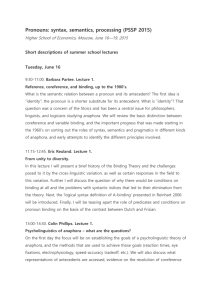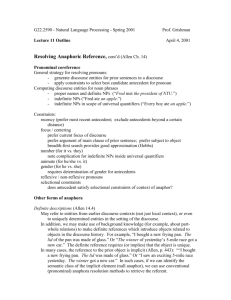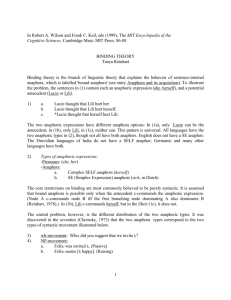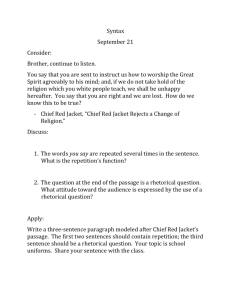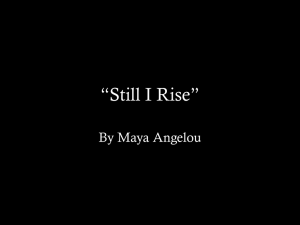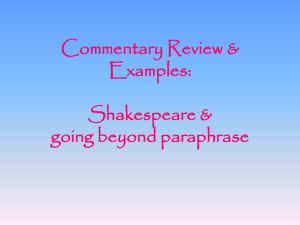1. What is Anaphora?
advertisement
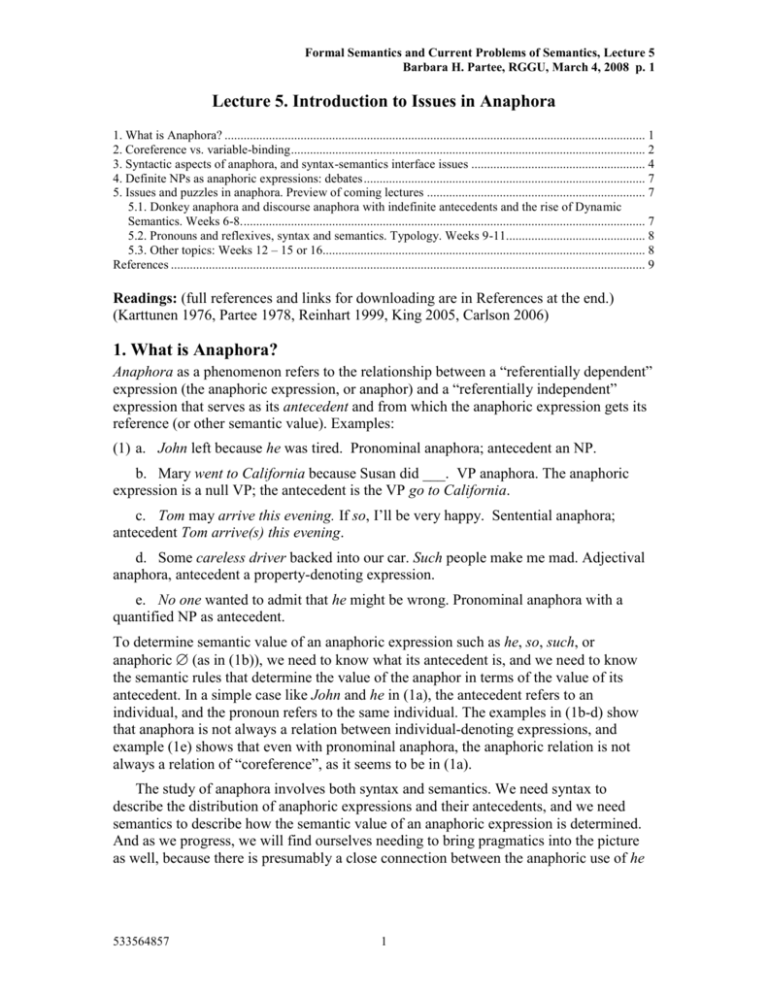
Formal Semantics and Current Problems of Semantics, Lecture 5 Barbara H. Partee, RGGU, March 4, 2008 p. 1 Lecture 5. Introduction to Issues in Anaphora 1. What is Anaphora? ..................................................................................................................................... 1 2. Coreference vs. variable-binding ................................................................................................................ 2 3. Syntactic aspects of anaphora, and syntax-semantics interface issues ....................................................... 4 4. Definite NPs as anaphoric expressions: debates ......................................................................................... 7 5. Issues and puzzles in anaphora. Preview of coming lectures ..................................................................... 7 5.1. Donkey anaphora and discourse anaphora with indefinite antecedents and the rise of Dynamic Semantics. Weeks 6-8. ............................................................................................................................... 7 5.2. Pronouns and reflexives, syntax and semantics. Typology. Weeks 9-11............................................ 8 5.3. Other topics: Weeks 12 – 15 or 16...................................................................................................... 8 References ...................................................................................................................................................... 9 Readings: (full references and links for downloading are in References at the end.) (Karttunen 1976, Partee 1978, Reinhart 1999, King 2005, Carlson 2006) 1. What is Anaphora? Anaphora as a phenomenon refers to the relationship between a “referentially dependent” expression (the anaphoric expression, or anaphor) and a “referentially independent” expression that serves as its antecedent and from which the anaphoric expression gets its reference (or other semantic value). Examples: (1) a. John left because he was tired. Pronominal anaphora; antecedent an NP. b. Mary went to California because Susan did ___. VP anaphora. The anaphoric expression is a null VP; the antecedent is the VP go to California. c. Tom may arrive this evening. If so, I’ll be very happy. Sentential anaphora; antecedent Tom arrive(s) this evening. d. Some careless driver backed into our car. Such people make me mad. Adjectival anaphora, antecedent a property-denoting expression. e. No one wanted to admit that he might be wrong. Pronominal anaphora with a quantified NP as antecedent. To determine semantic value of an anaphoric expression such as he, so, such, or anaphoric (as in (1b)), we need to know what its antecedent is, and we need to know the semantic rules that determine the value of the anaphor in terms of the value of its antecedent. In a simple case like John and he in (1a), the antecedent refers to an individual, and the pronoun refers to the same individual. The examples in (1b-d) show that anaphora is not always a relation between individual-denoting expressions, and example (1e) shows that even with pronominal anaphora, the anaphoric relation is not always a relation of “coreference”, as it seems to be in (1a). The study of anaphora involves both syntax and semantics. We need syntax to describe the distribution of anaphoric expressions and their antecedents, and we need semantics to describe how the semantic value of an anaphoric expression is determined. And as we progress, we will find ourselves needing to bring pragmatics into the picture as well, because there is presumably a close connection between the anaphoric use of he 533564857 1 Formal Semantics and Current Problems of Semantics, Lecture 5 Barbara H. Partee, RGGU, March 4, 2008 p. 2 in (1a) and what is sometimes called a deictic use1 of he in (2), as it might be uttered while looking at someone who just walked by, where there is no linguistic antecedent. (2) He looks lost. Two notes on terminology. In the broad sense of the term anaphora, all of the examples above as well as the ones in (3) below involve anaphora. There are two narrower senses in which anaphora or anaphor are distinguished from other terms. Anaphora vs. cataphora. In all the examples above, the anaphoric expression follows the antecedent. But sometimes it may precede, as in (3); that is known either as backwards anaphora (this is the more common term in contemporary western syntax) or cataphora (a classic term); in this case the term “antecedent” is also a misnomer but is only rarely replaced by postcedent. (3) a. If you can find it, I would recommend buying the 1977 Vishnevskaya recording. b. As we have __ in the past, WFCR will continue to bring you the finest music. c. I can’t believe it! We won! d. You must remember this: A kiss is just a kiss; a sigh is just a sigh. (from Casablanca, the song “As Time Goes By”) Anaphors vs. pronominals. In his “Binding Theory”, Chomsky has emphasized the difference in syntactic distribution among three classes of expressions, which he calls “anaphors”, “pronominals”, and “R-expressions” (“referential expressions”). Reflexive pronouns like himself, myself, Russian sebja and –sja are called “anaphors”, while ordinary personal pronouns like he, him are called “pronominals” and distinguished from anaphors. The term “anaphor” therefore has a much narrower meaning in Chomskian syntax than the way I have used it above. We’ll introduce the basics of Chomsky’s Binding Theory in Section 3 below. If we followed Chomsky’s terminology, none of the anaphoric expressions in the examples above would be called anaphors, but the anaphoric expressions in (4) below would be. (4) a. Bill loves only himself. b. Vanja ljubit sebja. c. Oni čitali žaloby drug na druga. (Testelets 2001, p.602) We will use the terms anaphora and anaphor in the broad sense in which they apply to all the examples in (1-4), except when explicitly discussing Chomskian Binding Theory. 2. Coreference vs. variable-binding The main question in the semantics of anaphora is this: What is the semantic relation between an anaphoric expression and its antecedent? Is it always the same, or is there more than one kind of anaphora from a semantic point of view? 1 There are a pair of rare terms that are useful here: endophora for the case where a referentially dependent sentence gets its value from a linguistic expression within the same text, and exophora for a case like that in (2) where it gets its value from outside the linguistic context. But those terms are very rarely used. 533564857 2 Formal Semantics and Current Problems of Semantics, Lecture 5 Barbara H. Partee, RGGU, March 4, 2008 p. 3 One possibility: Coreference When the antecedent is a proper name, as in (1a) and (4a), a natural first hypothesis is that the relation is one of coreference: the antecedent is an e-type expression that denotes (refers to) an individual, and the pronoun “picks up the reference of” its antecedent. Another possibility: Bound variable anaphora But we can see in example (1e), and we saw earlier in Lecture 3 (section 3.4, p.11), that sometimes a personal pronoun is interpreted as a bound variable, not as a referring expression that is “coreferential” with its antecedent. Does that mean that we need two different interpretation rules for pronouns? Montague (1973): All pronouns treated as bound variables. What does the binding? Review Lecture 3! It’s not directly the “antecedent”; the actual binding is always done by a lambda-operator! But informally we often speak of an NP a binding a bound-variable pronoun if the lambda-operator is part of the interpretation of the ‘quantifying in’ rule. See Homework 2, optional exercise 7: the derivation in our fragment of Every professori knows a student who admires himi. No treatment of exophora in Montague’s work (pronouns with non-linguistic antecedents), but a natural extension is to treat those as “free variables” with values provided by the context. No treatment of reflexive pronouns. Argument for two different interpretation rules: the strict-sloppy identity problem, introduced in Lecture 1, and repeated here. Sentence (5) has one obvious ambiguity – “his” can mean “John’s”, or it can have a referent outside the sentence – someone else that we have been talking about, for instance Max. Such an ambiguity is sometimes notated as follows: (5) Johni loves hisi/j wife. (I.e. his can have the same “referential index” as John or a different one.) But the ambiguity of (6) raises a further puzzle. (6) involves “VP (Verb Phrase) anaphora”: “so does” is anaphoric to the VP of the first sentence, “loves his wife”. (6) John loves his wife and so does Bill. Possible interpretations: (i) John loves Max’s wife, and Bill loves Max’s wife. (“loves hisj wife”, hej = Max) (ii) John loves John’s wife, and Bill loves John’s wife. (“loves hisi wife”, hei = John ) (iii) John loves John’s wife, and Bill loves Bill’s wife. (??? “loves self’s wife”? ) The contrast between (ii) and (iii) arises even when the first clause seems to unambiguously say that John loves John’s wife. Is that first clause actually ambiguous? In what way? The readings in (i) and (ii) are called “strict identity” readings, and (iii) “sloppy identity”. Why “sloppy”? (It’s J.R. Ross’s term; he was the first to discuss the phenomenon, in Ross (1967).) Because there isn’t always exact morpho-syntactic identity; cf. (7). (7) John can stand on his head, and Mary can too. (= “can stand on her head too”) 533564857 3 Formal Semantics and Current Problems of Semantics, Lecture 5 Barbara H. Partee, RGGU, March 4, 2008 p. 4 Keenan, Partee, and others argued that so-called “sloppy identity” is strict semantic identity involving bound variable readings of pronouns. Pragmatic anaphora. Partee (1978) argued that “coreferential” anaphora should be viewed as just one subcase of a more general phenomenon of “pragmatic anaphora”, unifying examples like (1a), (2) and (8) below as a variety of ways in which a pronoun can get its reference “from the context”, including both linguistic and non-linguistic context. (8) I couldn’t reach Elliot last night. He is probably in Boston. Partee (1978) argued: Where I do want to draw a sharp line is between the bound variable use and the pragmatic use of pronouns. The bound variable use is best described at the level of syntactic form and semantic interpretation of single sentences, and the relevant question is not what the pronoun refers to, but what quantifier phrase is binding it. The pragmatic use is best described at the pragmatic level, where the full context of the sentence in use is considered; on the syntactic level, these pronouns are really no different from proper names, and at the semantic level, they can be viewed as free variables or as dummy names. (p.112 in 2004 reprint; p.3 in the pdf file.) This is not a standard position, but it is not far away in spirit from ideas in Reinhart’s work (Reinhart 1976, 1983b, 1983a, Grodzinsky and Reinhart 1993, 1993) and in the work of Bach and Partee (Bach and Partee 1980, Partee and Bach 1981). In any case, every theory has to have something to say about the basic differences between “coreferential anaphora” and “bound variable anaphora”, and every theory has to have something to say about the relation between the anaphoric use(s) of pronouns and their “free” or “exophoric” uses. 3. Syntactic aspects of anaphora, and syntax-semantics interface issues There has been even more work on the syntax of anaphora than on its semantics, because the syntactic distribution of various anaphoric expressions has raised challenges that have played a major role in various developments in syntactic theory, most famously but not only in Chomskian theories. A central syntactic question is how to best describe and explain the differences in distribution between “plain pronouns” like he, she, it (called pronominals, or pronouns, in Chomskian Binding Theory) and reflexive pronouns himself, herself, itself (anaphors in Chomskian Binding Theory), and similar forms in other languages. Reinhart and Chomsky are two of the classic names in this endeavor; Chomsky is more prominent among syntacticians, while semanticists especially appreciate Reinhart for her equal attention to syntactic and semantic aspects of the problem. Reinhart (1999) begins as follows (I’ve changed the example number): Binding theory is the branch of linguistic theory that explains the behavior of sentence-internal anaphora, which is labelled 'bound anaphora' …. To illustrate the problem, the sentences in (9) each contain an anaphoric expression (she, herself), and a potential antecedent (Lucie or Lili). 533564857 4 Formal Semantics and Current Problems of Semantics, Lecture 5 Barbara H. Partee, RGGU, March 4, 2008 p. 5 (9) a. Lucie thought that Lili hurt her. b. Lucie thought that Lili hurt herself. c. *Lucie thought that herself hurt Lili. The two anaphoric expressions have different anaphora options: In (9a), only Lucie can be the antecedent; in (9b), only Lili; in (9c), neither can. This pattern is universal. (Reinhart 1999, p.86) Binding Theory, especially on Reinhart’s account, is concerned primarily with the distribution of reflexive pronouns like herself, but is also concerned with the differences between the distributions of pronominals and of reflexive pronouns. What does “binding” mean in syntax? Roughly, ‘bound’ in syntax means ‘co-indexed with a c-commanding2 NP.’ Skipping the technical definition of a “local domain”, which to a first approximation can be thought of as a “clause”, the Binding conditions proposed in (Chomsky 1981) can be summarized as follows: (10) Binding conditions Condition A: An anaphor must be bound in its local domain. Condition B: A pronoun must be free in its local domain. Condition C: An R-expression must be free. These conditions rule out the impossible choices of co-indexing in (9), and also account for the contrasts in the following. (11) a. Felixi invited himselfi. b. *Felixi invited himi. (12) a. Felixi heard himselfi sing. b. *Felixi heard himi sing. (13) a. Luciei believes that we should elect heri. b. *Luciei believes that we should elect herselfi. It is argued that these conditions are universal, with parametric variation across languages (and perhaps even across particular subclasses of anaphors and pronominals within a language) on the relevant definition of “local domain”. Typological issues. English vs. Russian. Testelets (2001, pp. 600-603) discusses work of Rappaport (1986), who argued that a difference between English and Russian is that for English anaphors, a crucial factor for local domains is the notion of “accessible subject”, which includes subjects of both finite and infinitive clauses, while for Russian reflexives, what is crucial is the domain of a finite subject, and for the distribution of Russian reciprocal drug druga (also an anaphor), the domain of any subject, including e.g. dative agents, is a local domain. This explains, among other things, the difference between the English examples (14a-b) and the Russian examples (15a-b). 2 Node A c-commands node B in a constituent structure tree if the first branching node that dominates A also dominates B. 533564857 5 Formal Semantics and Current Problems of Semantics, Lecture 5 Barbara H. Partee, RGGU, March 4, 2008 p. 6 (14) a. John thinks that a picture of himself will be in the show. b. Theyi asked the journalistsj [PROj to write an article about themselves*i/j] (15) a. *Ivan dumaet, čto svoja fotografija budet na vystavke. b. Onii poprosili žurnalistovj [PROj napisat’ o sebei/j stat’ju] Typology of pronouns and anaphors is a big area of research, and we will return to it. Kinds of reflexives and hypotheses about the syntax-semantics interface. One view of reflexive pronouns is expressed in Binding theory: reflexive pronouns and other anaphors are anaphoric expressions that have to be bound by an antecedent. This view of anaphors makes them very similar to the bound-variable pronouns of Montague grammar, with additional syntactic principles to explain when a bound-variable pronoun should be expressed as a reflexive pronoun and when it should be expressed as a plain pronoun. There is another view of reflexives, which is particularly plausible for reflexive clitics like Russian –sja. This is the view of reflexives as operators on verbs: reflexivization turns a 2-place verb into a 1-place verb by identifying two of its arguments. Let R be a variable of type <e,<e,t>>, the type of simple transitive verbs like love, wash. Then we can define the semantics of an operator –sja as follows: (16) TR( -sja ) = λRλx[R(x,x)] If we apply that operator to a transitive verb like myt’ ‘wash’, we obtain as the interpretation of myt’sja the following, assuming that wash’ is the translation of myt’: (17) TR (myt’sja) = λRλx[R(x,x)] (wash’) = λx[wash’(x,x)] On this view, a “reflexive” is not a kind of NP, but rather a kind of operator on verb meanings. This view has some plausibility for reflexives expressed by bound morphemes on verbs, whose semantics is often limited to indicating identification of subject and direct object arguments. It is less plausible for reflexives that have a form and distribution more like pronouns and other full NPs. But there are views of reflexives that combine aspects of the operator view and of the “pronoun-like” view, for instance (Bach and Partee 1980). For some interesting work on the two Polish reflexives się and siebie, see (Lubowicz 1999). For extensions of that work to Russian –sja and sebja, see (Kapitonov 2007). “Anti-reflexives”. Saxon (1984) discusses the phenomenon of “disjoint anaphora” in Dogrib, an indigenous language of western Canada. “Disjoint anaphors” are expressions whose syntactic distribution is constrained in the same way as typical anaphors, but their interpretation is not “identical to the antecedent” in the way that a reflexive is, but rather they denote some salient individual necessarily different from the “antecedent” (which typically means “different from the subject”.) This work is particularly interesting in how it helps to distinguish the syntactic notion of “anaphor subject to Principle A” from the semantic notion of “reflexive”. The treatment of full-NP reflexives in Polish and Russian 533564857 6 Formal Semantics and Current Problems of Semantics, Lecture 5 Barbara H. Partee, RGGU, March 4, 2008 p. 7 actually resembles the treatment of disjoint anaphors in Dogrib. But the details will have to wait until we discuss reflexives later in the semester. Exploring the typology of pronouns and anaphors. It has been claimed in some of my work and elsewhere that in English, reflexive pronouns (almost) always express bound variable anaphora, whereas plain pronouns can express either bound variable anaphora or pragmatic anaphora. So, for example, in contrast with the strict vs. sloppy identity ambiguity in (6), we get only a “sloppy identity” reading (i.e. a bound-variable anaphora reading) in (18) below: Frank must have photographed himself, not Daniel. (18) Daniel photographed himself, and Frank did too. Japanese has been reported to have overt pronouns that never express bound variable anaphora, and null pronouns that always express bound variable anaphora. Reinhart and Reuland, whose work we will look at later, raise very interesting hypotheses about further typological distinctions among reflexive pronouns. 4. Definite NPs as anaphoric expressions: debates Another issue in the discussion of anaphora is the semantics of definite NPs like the king, the chair. We have discussed so far only one family of views of the semantics of definites, that on which a definite noun phrase asserts or presupposes that one and only one entity satisfies the given description. This family of views may be called the uniqueness theory of definites. There is another theory, called the familiarity theory of definites. This theory finds support in examples like (19) below, which don’t seem to assert or presuppose uniqueness. (19) a. If a man beats a donkey, the donkey kicks him. (Heim 1982,p.227) b. A dog saw a cat. The cat meowed. (Heim, p. 241) On this theory, definite descriptions are also anaphoric. We will study such a theory when we study Heim’s dissertation in Lectures 6-8. There is some evidence that there are actually two kinds of definite expressions, some fitting the uniqueness theory and others fitting the familiarity theory; this evidence comes especially from languages in which there are morphological and/or lexical differences between two definite articles, as in certain dialects of German (Florian Schwarz, UMass dissertation in progress.) 5. Issues and puzzles in anaphora. Preview of coming lectures 5.1. Donkey anaphora and discourse anaphora with indefinite antecedents and the rise of Dynamic Semantics. Weeks 6-8. Anaphora with indefinite antecedents: Binding, coreference, or neither? How this problem together with the problem of “donkey anaphora” led to some major changes in semantic theory: Dynamic Semantics and the Kamp-Heim theory: Heim’s “File Change Semantics” and Kamp’s “Discourse Representation Theory. (Lectures 6-8). 533564857 7 Formal Semantics and Current Problems of Semantics, Lecture 5 Barbara H. Partee, RGGU, March 4, 2008 p. 8 Lecture 6. March 18. Kamp-Heim theory I. Discourse anaphora with indefinite antecedents; donkey anaphora; definites and indefinites. Previous approaches. Reading: (Heim 1982). Read Chapter 1. Dissertation available as a djvu file or as a very large PDF file. We will try to have a CD available on March 18 for the class with this and other readings. Lecture 7. March 25. Kamp-Heim theory II. Heim's theory in its "Logical Form" version, and Kamp's Discourse Representation Theory. Reading: (1) Heim dissertation, Chapter 2. (2) (Kamp 1981) Optional readings: (3) (Heim 1983a) File change semantics and the familiarity theory of definiteness. (4) (Lewis 1979) Scorekeeping in a language game. (5) (Stalnaker 1978). Assertion. Homework #3: Heim's theory of indefinites, definites, quantifiers, and anaphora. Due April 8. Lecture 8. April 1. Kamp-Heim theory III. Definite NPs as anaphoric expressions. Parallels between anaphora and presupposition. Reading: (Heim 1983b). On the projection problem for presuppositions. Optional: Heim dissertation, Chapter 3. Other readings to be added. 5.2. Pronouns and reflexives, syntax and semantics. Typology. Weeks 9-11. Here we will look more at the syntactic and semantic issues concerning kinds of anaphoric expressions discussed above in connection with bound variable anaphora vs. coreferential or pragmatic anaphora, and in connection with Chomskian Binding Theory. Class participants will be invited to look at pronouns and reflexives in languages you know, and to share the results. Lecture 9. April 8. Pronouns and reflexives, syntax and semantics. Readings to be assigned: Chomsky, Reinhart, Bach&Partee, others. Homework #4: Look at issues of pronouns and reflexives in Russian and/or in other language(s) that you know, and prepare to give a very short presentation in class, with a short handout, April 22. Due April 22. Lecture 10. April 15. Pronouns and reflexives 2: typological issues. Readings to be assigned. Reinhart, Testelets, Lubowicz, others. Lecture 11: April 22: Pronouns and reflexives 3: Short presentations by class participants relating to pronouns and reflexives and typology. Homework #5: Write up a short report based on your presentation; this can be done in teams of two or more, comparing anaphora in two or more languages. Due at the time of Lecture 13 (probably May 13). 5.3. Other topics: Weeks 12 – 15 or 16. What other topics we will look at will be partly up to the class, so please give me suggestions anytime you think of them. If there are anaphora-related issues that you are already interested in, please let me know. Lectures 12 – 15 or 16: April 29, [no class May 6] May 13, 20, 27, June 3(?) lecture topics to be decided later, probably to include: Nominal and Temporal Anaphora; 533564857 8 Formal Semantics and Current Problems of Semantics, Lecture 5 Barbara H. Partee, RGGU, March 4, 2008 p. 9 Pragmatics and more about "Pragmatic Anaphora"; Verb Phrase anaphora, anaphora involving other categories (sentential, common noun phrase, adjectival and adverbial anaphora). Other possible topics include “Variable-free semantics”; anaphoric properties of distributivity markers; reciprocals; Anaphora in intensional contexts; topics in Russian anaphora. Participants in the class will help decide what we will cover in the last lectures, and there could be more student presentations and/or guest presentations. References Bach, Emmon, and Barbara H. Partee. 1980. Anaphora and semantic structure. In Papers from the Parasession on Pronouns and Anaphora, eds. Jody Kreiman and Almerindo E. Ojeda, 1-28. Chicago: Chicago Linguistic Society. [Reprinted in Partee, Barbara H. 2004. Compositionality in Formal Semantics: Selected Papers by Barbara H. Partee. Oxford: Blackwell Publishing, 122-152]. http://semanticsarchive.net/Archive/jAwNjhhM/ or https://udrive.oit.umass.edu/partee/ParteeBach80_Anaphora.pdf Carlson, Gregory. 2006. Anaphora. In Wiley Encyclopedia of Cognitive Science. https://udrive.oit.umass.edu/partee/Semantics_Readings/Carlson2006anaphora.pdf Chomsky, Noam. 1981. Lectures on Government and Binding: The Pisa Lectures. Dordrecht: Foris. Grodzinsky, Yosef, and Tanya Reinhart. 1993. The Innateness of Binding and Coreference. Linguistic Inquiry 24:69-102. Heim, Irene. 1982. The Semantics of Definite and Indefinite Noun Phrases, University of Massachusetts: Ph.D. dissertation; published 1989, New York: Garland. http://newstar.rinet.ru/~goga/biblio/heim (djvu) or http://semanticsarchive.net/Archive/Tk0ZmYyY/ (very large PDF file) Heim, Irene. 1983a. File change semantics and the familiarity theory of definiteness. In Meaning, Use and the Interpretation of Language, 164-190. Berlin: Walter de Gruyter. Reprinted in Portner and Partee, eds., 2002, 223-248. [Reprinted in Portner and Partee, eds., 2002, 223248]. http://newstar.rinet.ru/~goga/biblio/essential-readings/09-HeimFile.Change.Semantics.and.the.Familiarity.Theory.of.Definiteness.djvu Heim, Irene. 1983b. On the projection problem for presuppositions. In WCCFL 2: Second Annual West Coast Conference on Formal Linguistics, eds. M. Barlow et al., 114-125: Stanford University. [Reprinted in Portner and Partee, eds., 2002, 249-260]. http://newstar.rinet.ru/~goga/biblio/essential-readings/10-HeimOn.the.Projection.Problem.for.Presuppositions.djvu Kamp, Hans. 1981. A theory of truth and semantic representation. In Formal Methods in the Study of Language; Mathematical Centre Tracts 135, eds. J.A.G. Groenendijk et al., 277-322. Amsterdam: Mathematical Centre. [Reprinted in: Jeroen Groenendijk, Theo Janssen, and Martin Stokhof (eds.), 1984, Truth, Interpretation, Information, GRASS 2, Dordrecht: Foris, pp. 1-41. Reprinted in Portner and Partee, eds., 2002, 189-222]. http://newstar.rinet.ru/~goga/biblio/essential-readings/08-KampA.Theory.of.Truth.and.Semantic.Representation.djvu Kapitonov, Ivan. 2007. Two views of Russian reflexives. Ms. Moscow. https://udrive.oit.umass.edu/partee/Semantics_Readings/Kapitonov_RussianReflexives.pdf Karttunen, Lauri. 1976. Discourse referents. In Syntax and Semantics 7: Notes from the Linguistic Underground, ed. J. McCawley, 363-385. New York: Academic Press. [In Semantics: Critical Concepts in Linguistics. Javeier Gutiérrez-Rexach (ed.), Vol. III, pages 20-39. Routledge, 2003. Also in Syntax and Semantics 7: Notes from the Linguistic Underground, 363-85, J. D. McCawley (ed.), Academic Press, New York 1976. Translations: Textreferenten. In Semantik und Generative Grammatik, pages 175-197, F. Kiefer (ed.), 533564857 9 Formal Semantics and Current Problems of Semantics, Lecture 5 Barbara H. Partee, RGGU, March 4, 2008 p. 10 Athenaeum, Frankfurt 1972; Referenti testuali. In La linguistica testuale, pages 121-147, M.E. Conte (ed.), Feltrinelli, Milan 1977.]. http://www2.parc.com/istl/members/karttune/publications/archive/discref.pdf King, Jeffrey C. 2005. Anaphora. In The Stanford Encyclopedia of Philosophy (Fall 2005 Edition), ed. Edward N. Zalta. http://plato.stanford.edu/archives/fall2005/entries/anaphora/ Lewis, David. 1979. Scorekeeping in a language game. In Semantics from Different Points of View, eds. Rainer Bäuerle et al. Berlin: Springer Verlag. [Also in: Journal of Philosophical Logic 8, 339-359. Reprinted in David Lewis, Philosophical Papers: Volume I, Oxford: Oxford University Press, 233-249. Reprinted in Portner and Partee, eds., 2002, 162-177]. http://newstar.rinet.ru/~goga/biblio/essential-readings/06-LewisScorekeeping.in.a.Language.Game.djvu Lubowicz, Anna. 1999. Two views of Polish reflexives. In Proceedings of the Eighteenth West Coast Conference on Formal Linguistics (WCCFL XVIII), eds. Sonya Bird et al., 337-350. Somerville, MA: Cascadilla Press. Montague, Richard. 1973. The proper treatment of quantification in ordinary English. In Approaches to Natural Language, eds. K.J.J. Hintikka et al., 221-242. Dordrecht: Reidel. [Reprinted in Montague 1974, 247-270; Reprinted in Portner and Partee, eds., 2002, 17-34]. http://newstar.rinet.ru/~goga/biblio/essential-readings/01-MontagueThe.Proper.Treatment.of.Quantification.in.Ordinary.English.djvu Partee, Barbara H. 1978. Bound variables and other anaphors. In Theoretical Issues In Natural Language Processing 2 (TINLAP-2), ed. David L. Waltz, 79-85. Urbana, IL: University of Illinois. [Reprinted in Partee, Barbara H. 2004. Compositionality in Formal Semantics: Selected Papers by Barbara H. Partee. Oxford: Blackwell Publishing, 110-121]. https://udrive.oit.umass.edu/partee/Partee78TINLAP.pdf or http://people.umass.edu/partee/docs/Partee78TINLAP.pdf Partee, Barbara H., and Emmon Bach. 1981. Quantification, pronouns and VP anaphora. In Formal Methods in the Study of Language, eds. J. Groenendijk et al., 445-481. Amsterdam: Mathematisch Centrum. [Reprinted in J.Groenendijk, T.Janssen, and M.Stokhof, eds., Truth, Information and Interpretation: Selected Papers from the Third Amsterdam Colloquium, Dordrecht: Foris, 99-130.]. http://semanticsarchive.net/Archive/jAwNjhhM/BHP_Bach81QuantificationPronounsVPAna phora.pdf Rappaport, Gilbert. 1986. On anaphor binding in Russian. Natural Langauge and Linguistic Theory 4:97-120. Reinhart, T. 1976. The Syntactic Domain of Anaphora, MIT: Ph.D. Reinhart, T. 1983a. Anaphora and semantic interpretation. London: Croom Helm. Reinhart, Tanya. 1983b. Coreference and Bound Anaphora: A Restatement of the Anaphora Question. Linguistics and Philosophy 6:47-88. Reinhart, Tanya. 1999. Binding theory. In The MIT Encyclopedia of the Cognitive Sciences, eds. Robert A. Wilson and Frank C. Keil, 86-88. Cambridge Mass: MIT Press. http://www.let.uu.nl/~tanya.reinhart/personal/Papers/pdf/BINDIN-3.FIN.word.pdf Reinhart, Tanya, and Eric Reuland. 1993. Reflexivity. Linguistic Inquiry 24:657-720. Ross, John Robert. 1967. Constraints on Variables in Syntax, MIT: Ph.D. dissertation. Saxon, Leslie. 1984. Disjoint anaphora and the binding theory. In WCCFL 3: Proceedings of the Third West Coast Conference on Formal Linguistics, eds. M. Cobler et al., 242-251. Stanford, CA: CSLI Publications. Stalnaker, R. 1978. Assertion. In Pragmatics, ed. Peter Cole, 315-332. New York: Academic Press. [Reprinted in Portner and Partee, eds., 2002, 147-161]. http://newstar.rinet.ru/~goga/biblio/essential-readings/05-Stalnaker-Assertion.djvu Testelets, Yakov G. 2001. Vvedenie v obshchij sintaksis [Introduction to General Syntax]. Moscow: Rossijskij Gosudarstvennyj Gumanitarnyj Universitet (RGGU). 533564857 10

